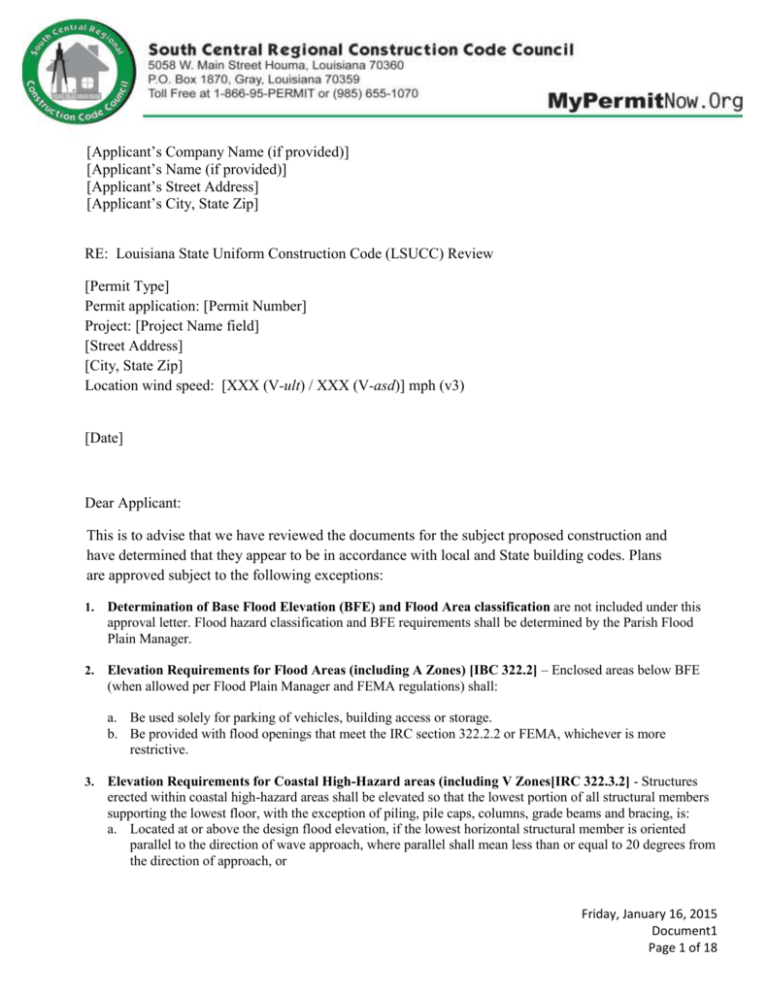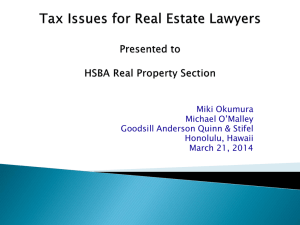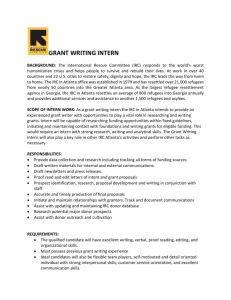New Construction Plan Review Letter Template
advertisement

[Applicant’s Company Name (if provided)] [Applicant’s Name (if provided)] [Applicant’s Street Address] [Applicant’s City, State Zip] RE: Louisiana State Uniform Construction Code (LSUCC) Review [Permit Type] Permit application: [Permit Number] Project: [Project Name field] [Street Address] [City, State Zip] Location wind speed: [XXX (V-ult) / XXX (V-asd)] mph (v3) [Date] Dear Applicant: This is to advise that we have reviewed the documents for the subject proposed construction and have determined that they appear to be in accordance with local and State building codes. Plans are approved subject to the following exceptions: 1. Determination of Base Flood Elevation (BFE) and Flood Area classification are not included under this approval letter. Flood hazard classification and BFE requirements shall be determined by the Parish Flood Plain Manager. 2. Elevation Requirements for Flood Areas (including A Zones) [IBC 322.2] – Enclosed areas below BFE (when allowed per Flood Plain Manager and FEMA regulations) shall: a. Be used solely for parking of vehicles, building access or storage. b. Be provided with flood openings that meet the IRC section 322.2.2 or FEMA, whichever is more restrictive. 3. Elevation Requirements for Coastal High-Hazard areas (including V Zones[IRC 322.3.2] - Structures erected within coastal high-hazard areas shall be elevated so that the lowest portion of all structural members supporting the lowest floor, with the exception of piling, pile caps, columns, grade beams and bracing, is: a. Located at or above the design flood elevation, if the lowest horizontal structural member is oriented parallel to the direction of wave approach, where parallel shall mean less than or equal to 20 degrees from the direction of approach, or Friday, January 16, 2015 Document1 Page 1 of 18 b. Located at the base flood elevation plus 1 foot, or the design flood elevation, whichever is higher, if the lowest horizontal structural member is oriented perpendicular to the direction of wave approach, where perpendicular shall mean greater than 20 degrees from the direction of approach. c. EXCEPTION: Where electrical, mechanical, and plumbing system components are not to be mounted on or penetrate through walls that are designed to break away under flood loads; and are constructed with insect screening or open lattice; or are designed to break away or collapse without causing collapse, displacement or other structural damage to the elevated portion of the building or structure [IRC 322.3.4] and the enclosed area is used solely for parking of vehicles, building access or storage [IRC 322.3.5]. 1. Policy Note – Structure Elevations: Utility Disconnects Prior to the first inspection when any structure is to be raised in excess of three (3) feet, permanent electric and gas utilities shall be disconnected from the structure and the temporary power pole (if required for construction purposes) shall be in place. The first inspection will be failed if permanent electric and gas utilities are still connected, or if a required temporary power pole is not in place. Permanent utilities will be restored when the elevated structure is found, on contractor requested final electrical and final gas inspection, to be stable, structurally sound, and provided with safe means of egress at all exit doors. Utility disconnect shall be included in the criteria for ‘Milestone One’ for HMGP funded elevations (as of June 2011). 2. Mechanical plan did NOT include type/size of hvac branch and trunk lines. Mechanical duct layout plan, with proper type/size listed, shall be submitted to and approved by this office 24 hours prior to scheduling mechanical inspection. 3. HVAC ACCA Manual J, Manual S Compliance Report and Manual D were NOT provided. Complete Manual “J”, “S" and "D" worksheet calculations shall be submitted to and approved by this office (SCPDC) prior installation of HVAC system. These reports shall also include all computation inputs, including but not limited to: wall/ceiling insulation and R-values, address for proposed project, design weather location, computation tonnage, sf of building, sizing of equipment, and equipment type. 4. ACCA Manual J NOT provided. Complete Manual “J” worksheet calculations shall be submitted to and approved by this office (SCPDC) prior installation of HVAC system. Manual “J” shall also include all computation inputs, including but not limited to: wall/ceiling insulation and R-values, address for proposed project, design weather location, computation tonnage, sf of building. 5. This review assumes that residential accessory building is to be located a minimum of 3 feet from dwelling unit and/or 5 feet from any interior property lines. If proposed construction is not located the minimum distances indicated, applicant shall submit site plans for reevaluation and approval. Less than the minimum distances indicated will require fireresistant-rated walls and design of those walls will need to be resolved and approved by this office prior to beginning construction. 6. This review assumes that proposed building is to be located a minimum of 5 feet from any interior property lines. If proposed construction is not located the minimum distances indicated, applicant shall submit site plans for re-evaluation and approval. Less than the Friday, January 16, 2015 Document1 Page 2 of 18 minimum distances indicated will require fire-resistant-rated walls and design of those walls will need to be resolved and approved by this office prior to beginning construction. 7. NOTE: The information below is for the newly renovated areas as indicated on the plans and does not included existing non-conforming conditions. The additional following comments identify issues for informational and cautionary purposes or issues that could not be verified in the submitted documents and will be inspected for code compliance in the field. Code References: IRC 2012 International Residential Code (Excluding Chapter 11 “Energy”) IRC 2009 International Residential Code Chapter 11 “Energy” Only NEC 2011 National Electric Code LSPC 2013 Louisiana State Plumbing Code ICC 600 2008 ICC Standard for Residential Construction in High-Wind Regions WFCM 2012 Wood Frame Construction Manual for One and Two Family Dwellings 8. Scope of Work: a) New Single Family Dwelling. b) New Two-Family Dwelling (Duplex). c) New XX unit Townhouse. d) New Residential Accessory Structure (Garage, Carport, or Storage Building). e) New addition to an existing residential home. f) New In-ground Swimming Pool. g) New Residential Modular Home. h) Relocation of Existing Residential Home. i) Residential Elevation. j) New Installation of Solar Power System. Friday, January 16, 2015 Document1 Page 3 of 18 9. Building Planning: a) Design load performance (110mph V-asd) requirements for Windows and/or Garage doors shall be indicated on the assembly and/or provide specifications from manufacturer to the inspector at time of inspection [IRC T301.2(2)]. NOTE: Minimum required design pressures for windows within 4 feet of building corners shall be +20.8/-27.2 (DP/HR 30) and a minimum +20.8/-22.6 (DP/HR 25) elsewhere. b) Design load performance (up to 120mph V-asd) requirements for Windows and/or Garage doors shall be indicated on the assembly and/or provide specifications from manufacturer to the inspector at time of inspection [IRC T301.2 (2)] NOTE: Minimum required design pressures for windows within 4 feet of building corners shall be +24.7/-32.4 ( DP/HR 35) and a minimum +24.7/-26.9 (DP/HR 30) elsewhere. Minimum design pressures FOR GARAGE DOORS (if applicable)shall be +22.0/-26.9 . c) Design load performance (125mph V-asd) requirements for Windows and/or Garage doors shall be indicated on the assembly and/or provide specifications from manufacturer to the inspector at time of inspection [IRC T301.2 (2)] NOTE: Minimum required design pressures for windows within 4 feet of building corners shall be +26.8/-35.1 ( DP/HR 35) and a minimum +26.8/-29.2 (DP/HR 30) elsewhere. Minimum design pressures FOR GARAGE DOORS (if applicable) shall be +23.9/-29.2. d) Design load performance (130mph V-asd) requirements for Windows and/or Garage doors shall be indicated on the assembly and/or provide specifications from manufacturer to the inspector at time of inspection [IRC T301.2 (2)] NOTE: Minimum required design pressures for windows within 4 feet of building corners shall be +29.0/-38.0 ( DP/HR 40) and a minimum +29.0/-31.6 (DP/HR 35) elsewhere. Minimum design pressures FOR GARAGE DOORS (if applicable) shall be +25.9/-31.6. e) Protection of openings required in “Wind Borne Debris Regions” (120mph or greater). Method provided shall be Large Missile Impact glazing complying with ASTM E 1996 and ASTM E 1886 or substituted with 7/16” wood structural panel with a maximum span of 8 feet [IRC 301.2.1.2]. Panel shall be pre-cut to match the framing surrounding the opening containing the product with the glazed opening. Panels shall be predrilled as required for the anchorage method and shall be provided with the attachment hardware per IRC Table R301.2 (2) or ASCE 7 [IRC 301.2.1.2]. NOTE: 7/16 wood structural panel cannot substitute the required design load performance requirements (DP/HR rating). f) Smoke alarms shall be provided in each sleeping room, outside each separate sleeping area in the immediate vicinity of the bedrooms and each additional story of the dwelling [IRC 314.3]. Smoke alarms shall be hard wired to the building power source and when primary source of power is interrupted, shall receive power from a battery [IRC 314.4]. Where more than one smoke alarm is required to be installed within a dwelling unit, the alarm devices shall be interconnected in such a manner that the actuation of one alarm will activate all aof the alarms [IRC 314.5]. See allowable exceptions for existing dwellings undergoing alterations, repairs, and additions. Friday, January 16, 2015 Document1 Page 4 of 18 g) Carbon Monoxide Alarms shall be installed outside of each separate sleeping area in the immediate vicinity of the bedrooms in dwelling units within which fuel-fired appliances are installed and in dwelling units that have attached garages [IRC 315.1]. h) Bathroom ventilation shall be provided by either mechanical means or by operable window [IRC 303.3] i) Stairways shall be provided with adequate illumination at top and bottom of stairway and controlled for activation at both the top and bottom [IRC 303.7] j) Safety Glazing shall be provided at “Hazardous Locations” per IRC 308.4 as follows: - Glazing in swinging, sliding and/or storm doors - Glazing in doors and enclosures for hot tubs, saunas, bathtubs, showers etc…. - Individual fixed or operable window within 24inches of door whose bottom edge is less than 60 Above floor - Individual fixed or operable window that meet all the following: Exposed area of individual pane has an area larger than 9 square feet Bottom edge less than 18 inches above floor Top edge more than 36 inches above floor One or more walking surfaces within 36 inches horizontally of the glazing - Glazing adjacent to stairways, landings, and ramps within 36 inches horizontally of a walking surface and less than 60 inches above walking surface - Glazing adjacent to stairways within 60 inches horizontally of the bottom tread of a stairway in any direction when the exposed surface of the glass is less than 60 inches above the nose of the tread. k) Dwelling/Garage fire separation: - Doors between garage and living space shall be 20 min. fire rated or 1 3/8” Solid or HoneyCombed [IRC 302.5.1]. Separation between attached and or detached garage less than 3 feet from house shall be provide with a minimum ½” Gyp wall and ceiling or 5/8” ceiling if provided room above [IRC 302.6]. No doors allowed directly between rooms used for sleeping and garages [IRC 302.5.1]. l) Emergency Escape and Rescue requirements: At least one window in each room used for sleeping shall meet all of the follow minimum requirements [IRC 310]: - Sill height not more than 44 inches - Minimum opening area of 5.7sf (5.0sf grade level floor) - Minimum opening height of 24 inches - Minimum opening width of 20 inches m) Address Identification – Buildings shall have approved address numbers, building numbers or approved building identification placed in a position that is plainly legible and visible from the street or road fronting the property. These numbers shall contrast with their background. Numbers shall be a minimum of 4 inches high with a minimum stroke width of ½ inch. Where access is by means of a private road and the building address cannot be viewed from the public way, a monument, pole or other sign or means shall be used to identify the structure [IRC 319.1]. 10. Flood Resistant Construction: Friday, January 16, 2015 Document1 Page 5 of 18 a) Buildings and structure constructed in whole or in part in flood hazard areas (including A or V Zones) shall be designed and constructed in accordance IRC 322.1. b) Protection of electrical and mechanical equipment below base flood elevation – No electrical systems, equipment or components; heating, ventilating, air conditioning; plumbing appliances and plumbing fixtures; duct systems; and other service equipment shall be located below base flood elevation UNLESS they are designed and installed to prevent water from entering or accumulating within the components and to resist hydrostatic and hydrodynamic loads and stresses including the effects of buoyancy, during the occurrence of flooding to the design flood elevation. Electrical wiring systems are permitted to be located below the required elevation provided they conform to the provisions of the 2011 NEC for wet locations [IRC 322.1.6]. c) Walls and partitions below design flood elevation shall be designed to break away walls [IRC 322.3.4] and be used solely for parking of vehicles, building access or storage [IRC 322.3.5]. d) Electrical, mechanical, and plumbing system components, where designed to be below base flood elevation, shall not be mounted on or penetrate through walls that are designed to break away [IRC 322.3.4]. e) All building materials used below design flood elevation shall be pressure treaded wood and/or water resistant materials [IRC 322.1.8]. 11. Exterior Windows: a) Where opening of operable window is located more than 72 above the finished grade or surface below, the lowest part of the clear opening of the window shall be a minimum of 24 inches above the finished floor of the room in which the window is located [IRC 312.2]. EXCEPTIONS: - Openings will not allow a 4-inch sphere to pass through - Opening s that are provided with fall prevention devices that comply with ASTM F 2090 - Windows that are provided with opening limiting devices that comply with IRC 312.2.2. 12. Means of Egress: a) Under enclosed stair shall be provided protection with 1/2 inch gypsum [R302.7] b) Stairways shall not be less than 36 inches in width [IRC 311.7.1] c) Stairways shall not be less than 31.5 inches in width between hand rails [IRC 311.7.1] d) Flight of stairs shall not have a vertical rise greater than 12 feet between floor levels or landings [IRC 311.7.3]. e) Hand rails shall not project more than 4.5 inches on either side of stairs [IRC 311.7.1]. f) Minimum head room in all parts of the stairway shall not be less than 6 feet 8 inches [IRC 311.7.2] g) Stair riser height maximum 7-3/4 inches w/maximum 3/8” difference of the smallest [IRC 311.7.5.1] Friday, January 16, 2015 Document1 Page 6 of 18 h) Tread depth minimum of 10 inches required [IRC 311.7.5.2] i) Hand rails shall be provide on one side of stairs with 4 or more risers [IRC 311.7.8] j) Handrail height shall not be less than 34 inches and not more than 38 inches [IRC 311.7.8.1] k) Ramps slope shall not be greater than 1:12 (8.3 percent slope) [IRC 311.8.1] l) Ramp shall be provided with a minimum 3-foot by 3-foot landing [IRC 311.8.2]. m) Guards with a height of 36 minimum shall be provided where walking surface is greater then 30 inches above finished grade and a height of 34 inches minimum on open sides of stairs were guards also serves as a handrails [IRC 312.1.2]. 13. Town houses: NOTE: Because sprinkler system requirements were not included with the LSUCC adoption of the 2012 IRC, the Louisiana State Uniform Construction Code Council adopted all separation requirements between dwelling units per the 2006 IRC section 317. a) Each Townhouse shall be considered a separate building and shall be separated by fireresistance-rated wall assemblies meeting the requirements of 2006 IRC section 302. Exception: A common 2-hour wall is permitted for town houses is such walls do not contain plumbing or mechanical equipment, ducts or vents in the cavity of the common wall [2006 IRC 317.2]. b) Applicant shall provide UL design used to achieve 1 or 2 hour separation [2006 IRC 317]. This method shall be submitted to and approved by this office (South Central Planning & Development Commission) prior to scheduling foundation pre-pour inspection. 14. Two Family Dwelling separation: NOTE: Because sprinkler system requirements were not included with the LSUCC adoption of the 2012 IRC, the Louisiana State Uniform Construction Code Council adopted all separation requirements between dwelling units per the 2006 IRC section 317. a) Dwelling units in two-family dwellings shall be separated from each other by wall and/or floor assemblies having not less than a 1 hour fire-resistance rating. Applicant shall provide UL design used to achieve 1 hour separations [2006 IRC 317.1]. This method shall be submitted to and approved by this office (South Central Planning & Development Commission) prior to scheduling foundation pre-pour inspection. 15. Energy: a) NOTE: Spray Foam Insulation (if applicable): IF SPRAY FOAM IS TO BE USED OR SPRAY FOAM IS LATER DECIDED TO BE USED AFTER PERMIT APPROVAL AND START OF CONSTRUCTION, THEN APPLICANT/CONTRACTOR SHALL RESUBMIT NEW HVAC ACCA MANUAL “J” LOAD CALCULATIONS. NEW MANUAL “J” SHALL INDICATE THE USE (I.E. WALL, CEILING, RAFTERS, VENTED OR UNVENTED ATTIC APPLICATION) AND TYPE OF SPRAY FOAM INSULATION. APPLICANT/CONTRACTOR SHALL ALSO PROVIDE PRODUCT INFORMATION AND/OR ICC ES REPORT NUMBER FOR Friday, January 16, 2015 Document1 Page 7 of 18 VERIFICATION OF PRODUCT USE AND R-VALUE THICKNESS REQUIREMENTS PRIOR TO INSTALLATION AND INSPECTION. b) Energy Efficiency Certificate – A permanent certificate, filled out by the builder or design professional, shall be posted on or in the electrical distribution panel upon completion of all energy requirements and prior to Final Building inspection. The certificate shall not cover or obstruct the visibility of the circuit directory label, service disconnect label or other required labels [IRC N1101.9]. See attached example certificate. This certificate or other approved certificate may be used as long as it is permanently installed and protected per notes above. See IRC section N1101.9 for additional instructions/clarifications on filling out this certificate. c) Insulation and Fenestration criteria [IRC 2009 Section 1100]: Windows shall meet the requirements of climate Zone 2 [IRC Table N1102.1]: (U-Factor 0.65 or less / SHGC of 0.35 or less) Exterior walls shall be R-13 minimum Ceilings shall be R30 minimum d) Access hatches and doors from conditioned spaces to unconditioned spaces (e.g. attics and crawl spaces) shall be weather stripped and have a minimum R-4 insulation value [IRC 1102.2.3 LSUCCC Amendment]. e) Building Thermal envelope shall be durably sealed to limit infiltration [IRC N1102.4]. f) Building envelop air tightness and insulation installation shall be demonstrated to comply with one of the following methods as chosen by the contractor, design professional or homeowner [IRC N1102.4.2 LSUCCC Amendment]: Option 1- Blower Door Test by certified personnel – If this option is used, then blower door test shall be performed by individuals certified to perform blower door tests by a nationally recognized organization [IRC N1102.4.2.1 LSUCCC Amendment]. Blower Door test reports and copy of certifier’s certification shall be submitted to and approved by this office prior to final inspection (NOTE – Tested air leakage shall be less than 7 ACH with a blower door at a pressure of 50 Pascal. If tested air leakage is less than 5 ACH then see notes under Mechanical section below for whole house ventilation requirements). Option 2 – Visual Inspection – Inspections of all items listed in IRC Table N1102.4.2 shall be scheduled with our office and conducted in accordance with those requirements. These inspections (“Energy Efficiency” inspections) may need to be conducted at different stages of construction in order complete all inspections areas prior to being covered up (See attached IRC Table for “Air Barrier and Insulation Inspection”). Talk to mike about another energy inspection called “Final Energy”. g) New wood burning fire places shall have outdoor combustion air [IRC N1102.4.3 LSUCCC Amendment]. h) Recessed Lighting - All recessed lighting fixtures shall be IC rated and Labeled [IRC N1102.4.5]. Recessed lighting shall NOT be located inside an air-tight box. i) Programmable Thermostat – Every dwelling unit with forced air heating equipment shall be provided with at least one programmable thermostat [IRC N1103.1.1]. Friday, January 16, 2015 Document1 Page 8 of 18 j) Duct Sealing – Ducts, air handlers, filter boxes and building cavities used as ducts shall be sealed. Duct tightness shall be verified by either a post-construction duct test or rough-in-duct tightness test. Exception – Duct tightness test not required if air handler and all ducts are located within the conditioned space [IRC N1103.2.2]. k) Duct Sealing Testing – Duct Sealing Testing shall be performed by individuals certified to perform duct sealing tests by a nationally recognized organization that trains and provides certification exams for the proper procedures to perform such test. Written test reports and a copy of the tester’s certification shall be submitted to and approved by our office prior to Final Mechanical Inspection [IRC N1103.2.2]. Exception – HVAC contractors, who are not certified to perform duct sealing test, may still perform the test as long as the building department inspector (our inspector) is present at time of test. Contractor must, first, schedule inspection with building department at which point the inspector will call to arrange time sufficient for both parties [IRC N1103.2.2 LSUCCC Amendment]. l) Mechanical System Piping Insulation – Mechanical system piping capable of carrying fluids above 105 degrees F. or below 55 degrees F. shall be insulated to a minimum R-3 [IRC N1103.3]. m) Pool Heaters - All pool heaters shall be equipped with a readily accessible on-off switch to allow shutting off the heater without adjusting the thermostat setting. Pool heaters fired by natural gas or LPG shall not have continuously burning pilot lights [IRC N1103.8.1]. n) Lighting Equipment – A minimum of 50% of the lamps in permanently installed lighting fixtures shall be high-efficacy lamps [IRC N1104.1]. 16. Foundations: a) Site preparation: The area within the foundation walls shall have all vegetation, top soil and foreign material removed [IRC 506.2]. b) Under Floor Space (crawl space where applicable) [IRC 408] Ventilation 1sf/150sf or provide with Class 1 vapor retarder on ground surface and ventilation openings not less than 1sf/1500sf of crawlspace area [IRC 408.1] Floor access shall be a minimum 18” x 24” inches and access through perimeter walls shall be a minimum 16” x 24” [IRC 408.4]. c) Exterior footings shall be a minimum of 12 inches into the natural undisturbed ground [IRC 403.1.4]. NOTE: This plan review assumes the subject proposed construction is being built on natural soil. If a mound of dirt has been constructed for this project, a compaction test will have to be submitted for review and approved prior to any work being done. Otherwise footings will have to continue to depth below the mound plus an additional 12” below natural undisturbed soil. d) Anchor bolts shall have a minimum embedment of 7 inches into the concrete [IRC 403.1.6] e) Outer bar of foundation reinforcing shall be continuous around corners using corner bars or by bending the bar with a minimum 25 inch overlap [SSTD 10-99 section 303.3.1] Friday, January 16, 2015 Document1 Page 9 of 18 17. Roof and Ceiling Construction: a) Truss shop drawings signed and sealed by designer shall be submitted to and approved by SCPDC prior to installation [IRC 802.10.1]. b) See SCPDC WFCM handout for ridge blocking requirements c) Attic access shall be provided where building is constructed of combustible material and has attic area that exceeds 30 square feet and have a vertical height of 30” or more [IRC 807.1]. d) Attic access shall be a minimum of 22”x 30” and be located in hallway or other readily accessible area [IRC 807.1]. 18. Roof Covering Material: a) Roof Cover material specifications by manufacture shall be available to inspector during time of inspection [IRC 905.1]. b) Asphalt shingles shall be rated for the design wind speed of area of proposed construction [IRC 905.2.4.1]. c) Asphalt shingle wrappers shall bear the label indicating compliance with any of the following test standards [IRC 905.2.4]: ASTM D 3161 Class F (Approved for 110MPH OR GREATER) ASTM D 7158 Class G (Approved for ONLY UP TO 120MPH) ASTM D 7158 Class H (Approved for ONLY UP TO 150MPH) ASTM D 6381 / UL 2390 Class G (Approved for ONLY UP TO 120MPH) ASTM D 6381 / UL 2390 Class H (Approved for ONLY UP TO 130MPH) MIAMI DADE approved (Approved for any wind zone our area) FASTENERS REQUIRED: 6 NAILS PER SHINGLE UNDERLAYMENT [IRC 905.2.7]: 15# felt underlayment for roofs between 2:12 to 4:12 slope shall be two layers (half-laped) 15 or 30 # felt is an approved underlayment with fasteners spaced a maximum of 36” O.C. Where felt overlaps successive sheets (see SCPDC roofing handout) 19. Drilling and Notching: a) Drilling and notching of wood structural members [IRC 502.8, 802.7 and 602.6]; See attached handout. 20. Electrical: a) Complete electrical drawings were not provided for review. The nature of the work appears to be such that review of design documents will not be necessary to obtain compliance. Inspection for compliance will be performed in the field. b) Protection of electrical equipment below base flood elevation – No electrical systems, equipment or components shall be located below base flood elevation UNLESS they are designed and installed to prevent water from entering or accumulating within the components and to resist hydrostatic and Friday, January 16, 2015 Document1 Page 10 of 18 hydrodynamic loads and stresses including the effects of buoyancy, during the occurrence of flooding to the design flood elevation. Electrical wiring systems are permitted to be located below the required elevation provided they conform to the provisions of the 2011 NEC for wet locations [IRC 322.1.6]. c) GFCI protection All receptacle outlets over kitchen counter tops shall be GFI protected [NEC 210.8(A)(6)] All Bathrooms outlets shall be GFI protected [NEC 210.8(A)(1)] All outlets within Garages shall be GFI protected [NEC 210.8(A)(2)] All outlets outdoors shall be GFI protected [NEC 210.8(A)(3)] Laundry, utility, and wet bar sinks – where the receptacles are installed within 6 feet of sink shall be GFI protected [NEC 210.8(A)(7)]. Exterior outlets shall be labeled weather resistant “WR” [NEC 406.9] All GFCI devices shall be readily accessible [NEC 210.8] d) Tamper Resistant Receptacles: All 125-volt, 15- and -20 ampere receptacles shall be Tamper Resistant Receptacles [NEC 406.12]. Exception: Receptacles located in the following areas shall not be required to be tamperresistant: Receptacles located more than 5’-1/2” above the floor. Receptacles that part of a luminaire or appliance Receptacles use in dedicated appliance space. Appliance not easily moveable. Non-grounding receptacles used for replacements as permitted in NEC 406.4(D)(2)(a). e) Arc Fault Protection: All 15 and 20 amp branch circuits supplying outlets in the following areas of a home shall be Arc Fault protected [NEC 210.12(A)]. Family Rooms Dining Rooms Living Rooms Parlors Libraries Dens Bedrooms Sunrooms Recreation rooms Closets Hallways Or similar rooms or areas f) Smoke alarms shall be provided in each sleeping room, outside each separate sleeping area in the immediate vicinity of the bedrooms and each additional story of the dwelling [IRC 314.3]. g) Smoke alarms shall be hard wired to the building power source and when primary source of power is interrupted, shall receive power from a battery [IRC 314.4]. Friday, January 16, 2015 Document1 Page 11 of 18 h) Required receptacle outlets: One receptacle outlet within 36” of bathroom sink [NEC 210.52(D)] One receptacle outlet at front and back of One- and Two-Family dwellings [NEC 210.52 (E)(1)] One receptacle outlet shall be provided within perimeter of all balconies, decks, and porches that are accessible from inside a dwelling unit regardless of size [NEC 210.52(E)(3)]. No point along wall is more than 24” from an outlet over kitchen counter top [NEC 210.52 (C)] No point along wall is more than 6 feet from a receptacle outlet [NEC 210.52 (A)] One receptacle outlet at hallway of 10 feet or more [NEC 210.52 (H)] Minimum one receptacle outlet in garage [NEC 210.52 (C)] i) Peninsular and island counter spaces with a minimum long dimension of 24 inches and short dimension of 20 inches shall be provided a minimum one outlet [NEC 210.52 (C)] j) Electrical services and panels shall have adequate working space and clearances [NEC 110.26] Depth of working space forward of the service or panel shall be a minimum 36” [NEC 110.26 (A)(1)] Width of working space forward of the service or panel shall be a minimum 30” [NEC 110.26 (A)(2)] k) Bonding requirements for water and gas piping: Metal piping systems shall be bonded to the service equipment enclosure. The point of attachment for bonding jumper(s) shall be accessible [NEC 250.104(B)]. 21. Solar Power: a) Complete solar power installation drawings were not provided for review. The nature of the work appears to be such that review of design documents will not be necessary to obtain compliance. Inspection for compliance will be performed in the field. b) All structural components to be installed per the Manufacturers Specifications for the wind speed noted above. c) All electrical components to be installed per NEC Article 690. 22. Swimming Pools, Spas, Hot Tubs and Hydromassage bathtubs: a) Complete electrical, plumbing and/or construction drawings were not provided for review. The nature of the work appears to be such that review of design documents will not be necessary to obtain compliance. Inspection for compliance will be performed in the field. b) All wiring methods used in conjunction with permanently installed swimming pools, hot tubs or Hydromassage bathtubs shall be installed in accordance with NEC article 680. c) All receptacles that provide power for water-pump motors or other loads directly related to the circulation and sanitation system shall be between 5 and 10 feet from the inside walls of pools, hot tubs and outdoor spas and hot tubs shall be single and of the locking an grounding type and shall be protected by GFCI [NEC 680.22(A)(1)]. Friday, January 16, 2015 Document1 Page 12 of 18 d) At least one 125-volt, 15- or 20-ampere receptacle shall be located a minimum of 10 feet from and not more than 20 feet from the inside wall of pools and outdoor spas and hot tubs except as per mitted by NEC Article 680.22(A)(4). This receptacle shall be located not more than 6 feet, 6 inches above the floor, platform or grade level serving the pool, spa or hot tub [NEC 680.22(A)(3)]. e) All 15- and 20-ampere, single phase, 125-volt receptacles located within 20 feet of the inside walls of pools and outdoors spas and hot tubs shall be GFI protected [NEC 680.22(A)(4)]. f) Indoor Locations. Receptacles shall be located not less than 6 feet from the inside walls of indoor spas and hot tubs. A minimum of one 125-volt receptacle shall be located between 5 and 10 feet [NEC 680.43(A) and (A)(1)]. g) Disconnect Means. One or more means of disconnect shall be provided for all equipment other than lighting. Such disconnect means shall be readily accessible and within sight of the equipment it serves [NEC 680.12] h) Luminaires and ceiling fans outdoors. Luminaires, lighting outlets and paddle fans shall not be installed over the pool or over the area extending 5 feet from the inside walls of pool except where fixture is no less than 12 feet above maximum water level [NEC 680.22(B)(1)]. i) Luminaires and ceiling fans indoors. Luminaires, lighting outlets and paddle fans, where not allowed outdoors, shall be allowed indoors provided the following [NEC 680.22(B)(2)]: Luminaires are of a totally enclosed type; GFCI is installed in the branch circuit supplying the luminaires or ceiling fan; Luminaires and fans shall be no less than 7’-6” from maximum water level. j) Bonding. All metallic parts of pool, spa and hot tub structures, including the reinforcing metal of pools, spa and hot tub shells, coping stones, and decks shall be bonded together [NEC 680.26]. 23. Mechanical: a) Complete mechanical drawings were not provided for review. The nature of the work appears to be such that review of design documents will not be necessary to obtain compliance. Inspection for compliance will be performed in the field. d) Garage – Fuel Fired appliances source of ignition at least 18” above floor where the appliance is NOT listed as flammable vapor ignition resistant [IRC M1307.3]. b) Mechanical equipment: 30” x 30” working space provided in front of control side of equipment located in attic [IRC M1305.1.3] Central furnaces within compartments or alcoves shall have a minimum 3 inch clearance along sides, back and top with total width of the enclosing space being at least 12 inches wider than the furnace [IRC M1305.1.1]. Attics containing appliances requiring access shall be provided with an opening and a clear and unobstructed passage large enough for the appliance but not less than 30 inches high and Friday, January 16, 2015 Document1 Page 13 of 18 22 inches wide [IRC M1305.1.3]; passageway shall have continuous solid flooring at least 24” wide. A luminaire controlled by a switch shall be provided at passageway opening for lighting in attic and a receptacle outlet shall be installed at or near the appliance location in accordance with NEC 2011 [IRC M1305.1.3.1]. c) Clothes dryer: Clothes dryers shall be vented to the exterior with back draft damper [IRC M1502.3] Clothes dryer exhaust duct shall be metal [IRC M1502.4.1] Clothes dryer exhaust duct lengths maximum 35 feet or as approved per the manufacturer’s installation instructions. (Not including 8 foot max flex duct connection at dryer [IRC M1502.4.4.1]. Clothes dryer ducts shall be permanently marked with label or tag to identify length when concealed within building construction and greater than 35 feet [IRC M1502.4.5]. d) Bathroom Mechanical Ventilation shall be provided with a minimum exhaust rate of 50CFMs intermittent or 20CFMs continuous [IRC M1507.4]. e) Combustion air [IRC G2407] Combustion air from inside of building [IRC G2407.5] Combustion air from outdoors [IRC G2407.6] Vertical ducts [IRC G2407.6.1] Horizontal ducts [IRC G2407.6.1] f) Furnaces and air-handling systems that supply air to living spaces shall not supply air to or return air from a garage [IRC M1601.6]. g) Ducts in the garage and ducts penetrating walls or ceilings separating the dwelling from the garage shall be constructed of a minimum No. 26 gage sheet steel or other approved material and shall have no openings into the garage [IRC 302.5.2]. h) HVAC ACCA MANUAL J, MANUAL S Compliance Report, AND MANUAL D reports shall be submitted to and approved by this office prior to beginning any mechanical work. Whether this report is provided and approved prior to issuing permit or after permit has been issued, any changes made on the project not correctly reflected in the above noted Manual’s, shall be resubmitted (in its entirety) and approved before continuing work on mechanical system (i.e. changes in type insulation, R-values used, changes in un-vented attic vs. vented attic, type or size of equipment as noted on Manual S) [IRC M1401.3 and M1601.1]. i) Equipment protection – Appliances shall not be installed in a location subject to automobile or truck damage except where protected by approved barriers [IRC 1307.3.1 LSUCCC Amendment]. j) Refrigerant circuit access ports located outdoors shall be fitted with locking-type tamperresistant caps or shall be otherwise secured to prevent unauthorized access [IRC M1411.6]. Friday, January 16, 2015 Document1 Page 14 of 18 k) Kitchen Exhaust Hoods – Kitchen Exhaust hoods capable of exhausting in excess of 400cfm’s shall be provided with makeup air at a rate approximately equal to the exhaust air rate. Such system shall be equipped with means of closure and shall be synchronized to operate with the operation of the exhaust hood [IRC 1503.4]. l) Whole House Ventilation system – When a blower door test is performed, and the air infiltration rate of a dwelling unit is less than 5 Air Changes per Hour (ACH) when tested in accordance with the 2009 IRC Section N1102.4.2.1, the dwelling unit shall be provided with whole-house mechanical ventilation in accordance with Section M1507.3 (see building envelope air tightness requirements under “Energy” section of this letter) [IRC 303.4 LSUCCC Amendment]. m) Cooking appliances used in dwellings must be listed and labeled for household use. Commercial cooking appliances are NOT permitted in dwelling units [IRC M1901.2 and M1901.3]. n) Factory-built or masonry fireplaces shall be equipped with an exterior air supply to assure proper fuel combustion [IRC 1006.1 LSUCCC Amendment]. 24. Mechanical – SOLAR ENERGY SYSTEMS a) Complete solar energy drawings were not provided for review. The nature of the work appears to be such that review of design documents will not be necessary to obtain compliance. Inspection for compliance will be performed in the field. b) Installation of thermal solar energy systems shall comply with Sections M2301.2.1 through M2301.2.9 [IRC M2301.2]. c) Solar energy collectors, controls, dampers, fans, and pumps shall be accessible for inspection, maintenance, repair and replacement [IRC M2301.2.1]. d) Connections from the potable water supply to solar systems shall be provided with back-flow protection in accordance with the 2013 Louisiana State Plumbing Code [IRC M2301.5 LSUCCC Amendment]. e) Roof shall be constructed to support the loads imposed by roof-mounted solar collectors [IRC M2301.2.2]. f) Installation, replacement, and repair of photovoltaic equipment and system components shall comply with manufacturer’s instructions, Sections M2302.2.1 through M2302.2.3 and NFPA 70 (NEC 2011) [IRC M2302.2]. g) Roof shall be of construction capable of supporting the loads imposed by photovoltaic panels and/or modules [IRC M2302.2.1]. Friday, January 16, 2015 Document1 Page 15 of 18 h) Ground-mounted panels and modules shall be installed in accordance with the manufacturer’s instructions [IRC M2302.2.3]. i) Photovoltaic panels and modules shall be listed and labeled in accordance with UL 1703 [IRC M2302.3]. j) Inverters shall be listed and labeled in accordance with UL 1741 [IRC M2302.4]. 25. Plumbing: a) Complete plumbing drawings were not provided for review. The nature of the work appears to be such that review of design documents will not be necessary to obtain compliance. Inspection for compliance will be performed in the field. b) Underground Piping within Buildings. All underground drains within buildings shall be cast iron soil pipe, type 316L stainless steel, ductile-iron pipe, type DWV copper, heavy schedule borosilicate glass, or Schedule 40 plastic piping. Materials subject to corrosion shall be protected when installed in corrosive soils [LSPC 703(D)]. c) Minimum Size Building Sewer. No building sewer shall be less than 4 inches in size with the exception of force lines [LSPC 705(F)]. Building Sewer—that part of the horizontal piping of a drainage system which extends from the ends of the building drain and which receives the discharge of the building drain and conveys it to the lateral or main community sewerage system or treatment plant. d) No more than 2 toilets shall be connected to a 3 inch building drain [LSPC TABLE 725.A.1]. Building Drain—that part of the lowest piping of a drainage system which receives the discharge from soil pipes and waste pipes inside the walls of the building and conveys it to the building sewer 3 ft (914 mm) outside the building wall. e) Backflow and back-siphonage protection of potable water shall be provided in accordance with LSPC section 609. f) Cleanouts provided for every 50 feet for 3 inch and 80 feet for 4 to 6 inch piping [LSPC 717(B)(4)] g) Every building in which plumbing is installed shall have at least one main vent stack or stack vent, of not less than 3-inch diameter, for each building drain, when connected separately to a building sewer, septic tank, or other disposal system approved by the plumbing official. Such vent shall run undiminished in size and as directly as possible from the building drain through to the open air above the roof [LSPC 905(C)(1)]. h) Island fixture venting shall be provided per LSPC section 911(A). i) Air admittance valves are NOT APROVED for venting of plumbing fixture traps [LSPC 907(G)]. Friday, January 16, 2015 Document1 Page 16 of 18 Changes to construction in the field which are not consistent with the reviewed documents are not authorized unless reviewed by this office (IRC 106.4). This review shall in no way permit and/or authorize any omission or deviations from the specific requirements of the adopted codes, rules and regulations (IRC 105.4). Work shall not be done beyond the point indicated in each successive inspection without first obtaining the approval of the building official. The building official upon notification shall either indicate the portion of the construction that is satisfactory as completed, or shall notify the permit holder or an agent of the permit holder wherein the same fails to comply with the 2012 International Residential Code. Any portions that do not comply shall be corrected and such portion shall not be covered or concealed until authorized by the building official (IRC 109.4). Occupancy of the project will not be permitted until all required inspection listed below have been accomplished by this office. To schedule an inspection call (985) 655-1070. The following inspections are required for this project: (Applicant shall also call for partial inspections and/or additional inspections specific to this project not identified below) 1. 2. 3. 4. 5. 6. 7. 8. 9. 10. 11. 12. 13. 14. 15. 16. 17. 18. 19. 20. 21. 22. Temporary Power Pole (If required) In-ground Plumbing/Site Degrass Foundation Inspection (Prior to Pour) Nail Pattern – Roof Sheathing Nail Pattern – Wall Sheathing Framing Framing (Metal, Wood, CMU reinforcement, etc…) Open Wall Electrical Open Wall Plumbing Open Wall Mechanical Open Fire Wall/Ceiling Insulation Final Electrical Final Mechanical Final Plumbing Final Fire Wall/Ceiling Attic Insulation Final Building Final Inspection Pre-pour Gunite/Concrete Grid Bonding Pre-pour Deck Grid Bonding Swimming Pool Final Friday, January 16, 2015 Document1 Page 17 of 18 Brian Craigo Deputy Building Official South Central Regional Construction Code Council Brian@SCPDC.org Friday, January 16, 2015 Document1 Page 18 of 18









